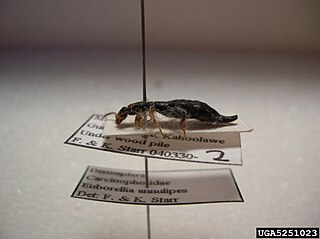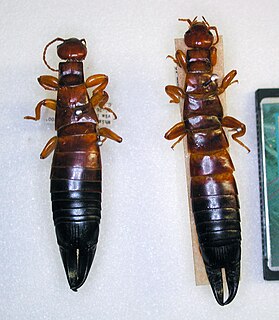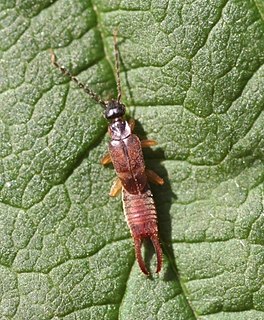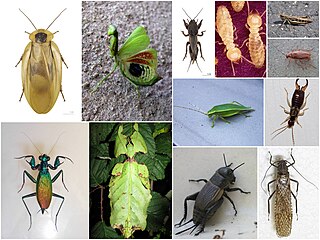Labium is the Latin word for lip. In English, it may refer to:

Forficula is a genus of earwigs in the family Forficulidae. The best known species is Forficula auricularia.
Archidermapteron martynovi is an extinct species of earwig, in the genus Archidermapteron, family Protodiplatyidae, the suborder Archidermaptera, the order Dermaptera, and is the only species in the genus Archidermapteron, which simply means "ancient member of the Dermaptera". It had long, segmented cerci unlike modern species of Dermaptera, but tegmina and hind wings that folded up into a "wing package" that are like modern earwigs. The only clear fossil of the species was found in Russia.

Anisolabididae is a family of earwigs, in the suborder Forficulina and the order Dermaptera. It is one of nine families in the suborder Forficulina, and contains thirty-eight genera spread across thirteen subfamilies.
Aborolabis is a genus of earwigs in the subfamily Anisolabidinae. It was cited by Srivastava in Part 2 of Fauna of India.
Isolaboides is a genus of earwigs, the sole member of the subfamily Isolaboidinae. It was cited by Srivastava in Part 2 of Fauna of India.
Placolabis is a genus of earwigs in the subfamily Anisolabidinae. It was cited by Srivastava in Part 2 of Fauna of India.

Titanolabis is a genus of earwigs in the subfamily Anisolabidinae. It was cited by Srivastava in Part 2 of Fauna of India. Among its species is the Australian T. colossea, which at about 5 cm (2.0 in) long is the largest certainly living species of earwig.

Diplatyidae is a family of earwigs in the suborder Neodermaptera. It contains only one subfamily, Diplatyinae, which contains six genera, five modern and one extinct known from fossils. The genus Tytthodiplatys was described in 2011 from a fossil found in Burmese amber which dates to the Albian age of the Cretaceous. It was not placed into the subfamily Diplatyinae, and is the oldest confirmed member of the family.

Labia minor, the lesser earwig or small earwig, is a species of earwig. It is widespread globally in temperate climates, preferring warm locations such as compost heaps in parts of its range. It is 4–7 mm long, including the pincer, and chocolate brown in color.
Araeomerus morrisi is a species of earwig, in the genus Araeomerus, family Hemimeridae, suborder Hemimerina.

Astreptolabis is an extinct genus of earwig in the Dermaptera family Pygidicranidae known from a Cretaceous fossil found in Burma. The genus contains a single described species, Astreptolabis ethirosomatia and is the sole member of the subfamily Astreptolabidinae.

Tytthodiplatys is an extinct genus of earwig in the family Diplatyidae known from a Cretaceous fossil found in Myanmar. The genus contains a single described species, Tytthodiplatys mecynocercus.
Zigrasolabis is an extinct genus of earwig in the family Labiduridae known from Cretaceous fossils found in Myanmar. The genus contains a single described species, Zigrasolabis speciosa.
Toxolabis is an extinct genus of earwig in the dermapteran family Anisolabididae known from a Cretaceous fossil found in Burma. The genus contains a single described species, Toxolabis zigrasi.

The cohort Polyneoptera is probably the most appropriate taxonomic ranking for commonly-used terms such as Orthopteroid insects: namely the orders similar to the Orthoptera. They are all winged insects (Pterygota), derived from ancestors that evolved to fold their wings (Neoptera) and possess biting mouthparts, but undergo little or no metamorphosis.








